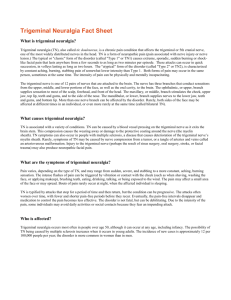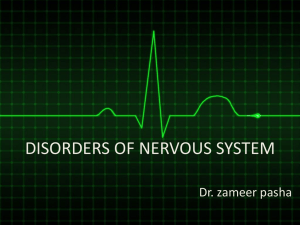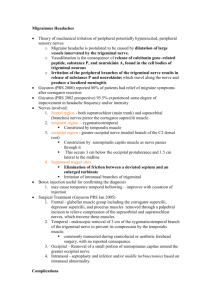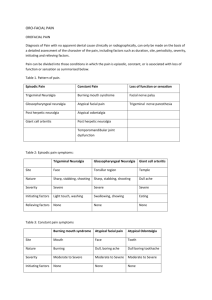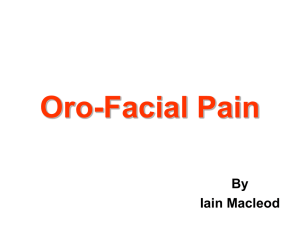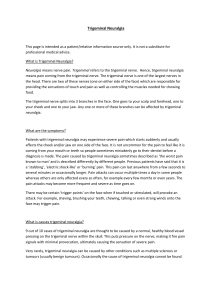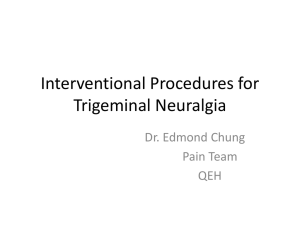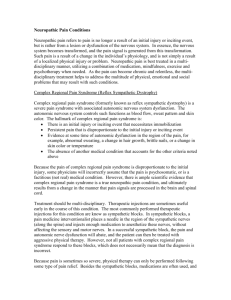Trigeminal Neuralgia
advertisement
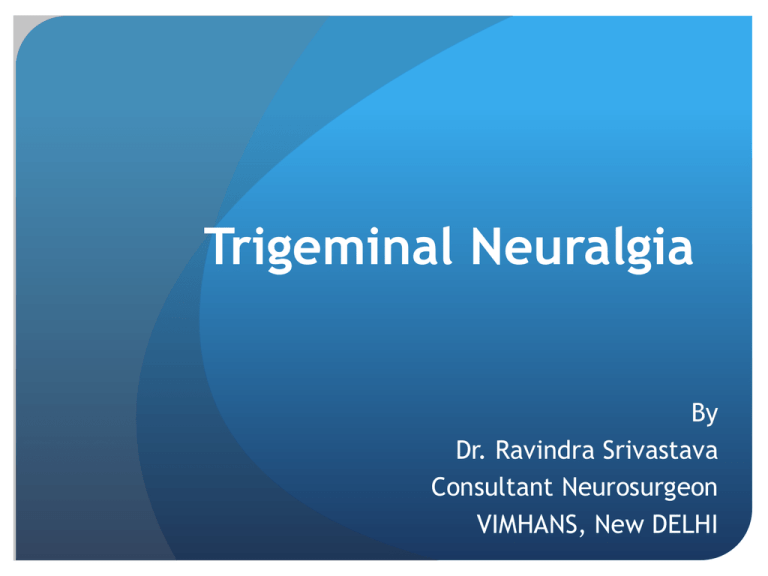
Trigeminal Neuralgia By Dr. Ravindra Srivastava Consultant Neurosurgeon VIMHANS, New DELHI Paroxysms of severe, lancinating, electric shock-like bouts of facial pain, lasting for seconds to minutes and restricted to distribution of the trigeminal nerve. No neurologic deficit is present and is not attributed to another disorder. Incidence : 4-5/ 1,00,000 Female Predominance (Male: Female = 1:2 – 2:3 usually unilateral (Right Side) mandibular (60%) (V3) maxillary (V2) (35%) ophthalmic VI branch (5%) Trigger zones - cheek, lip, nose or buccal mucosa. Triggers - shaving, brushing teeth, drinking, eating or even slight breeze Etiology - Idiopathic (Vascular) - Tumour V (nerve) Schwannoma or Cerebello pontine angle Tumors - Herpes Simplex virus infection - Multiple Sclerosis 4% of Patients with Multiple sclerosis have Trigeminal Neuralgia 2% Patients with Trigeminal Neuralgia have Multiple sclerosis Vascular- Aberrant loop of artery -Superior cerebellar artery (75.5%), - AICA (9.6%) -PCA (0.7%) or -vein (68.2%) found to be compressing the root entry zone of the V nerve in 80-90% of patients at surgery. Eliminating the compression provides long term relief. Investigations Whether there is an identifiable cause of disease, particularly with a view to surgical cure. MRI SCAN- 3D CISS with MPR sequences & MRA MRI scan should be obtained in -Younger Patient -Atypical clinical Features, including sensory loss or a dull burning pain between paroxysms -Patients who do not respond to initial medical therapy. Management Medical Surgical Gasserian ganglion level Procedures:-Micro vascular Decompression MVD Ablative treatments -Radiofrequency thermocoagulation (RFT) -Glycerol Rhizolysis (GR) -Ballon Compression (BC) -Stereotactic Radio surgery (SRS) Peripheral procedures -Peripheral Neuroectomy -Cryotheraphy -Alcohol Block MVD Concept of Dandy (1920) Popularized by Janetta. GOLD STANDARD as it deals the underlying cause. Retromastoid Sub occipital craniotomy, Retraction of superolateral margin of cerebellum, arachnoid is dissected & vessel freed, piece of shredded teflon placed between the vessel & the nerve to separate them. OF1185 pts treated by Barker at al with mean follow up of 6.5Yrs, 70% had excellent results at 10yrs. Our results in 10patients in whom MVD was done 80% -85% had excellent results over of period 5 Yrs. Thank You
